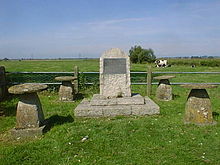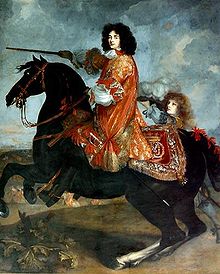Monmouth Rebellion

The Monmouth Rebellion of 1685, was an attempt to overthrow James II, who had become King of England, King of Scots and King of Ireland at the death of his elder brother Charles II on 6 February 1685. James II was unpopular because he was Roman Catholic and many people were opposed to a papist king. James Scott, 1st Duke of Monmouth, an illegitimate son of Charles II, claimed to be rightful heir to the throne and attempted to displace James II.
The rebellion ended with the defeat of Monmouth's forces at the Battle of Sedgemoor on 6 July 1685. Monmouth was executed for treason on 15 July, and many of his supporters were executed or transported in the "Bloody Assizes" of Judge Jeffreys.
Duke of Monmouth

Monmouth was an illegitimate son of Charles II. There had been rumours that Charles had married Monmouth's mother, Lucy Walter,[1] but no evidence was forthcoming,[2] and Charles always said that he only had one wife, Catherine of Braganza.[3]
Monmouth was a Protestant. He had been appointed Commander-in-Chief of the British Army by his father in 1672 and Captain-General in 1678, enjoying some successes in the Netherlands in the Third Anglo-Dutch War.[1] Monmouth's military reputation, and his Protestantism, made him a popular figure in England. An attempt was made in 1681 to pass the Exclusion Bill, an Act of Parliament to exclude James Stuart, Charles II's brother, from the succession and substitute Monmouth, but Charles outmanoeuvred his opponents and dissolved Parliament for the final time.[4][5] After the Rye House Plot to assassinate both Charles and James, Monmouth exiled himself to Holland, and gathered supporters in The Hague.[6]
So long as Charles II remained on the throne, Monmouth was content to live a life of pleasure in Holland, while still hoping to accede peaceably to the throne. The accession of James II put an end to these hopes. Prince William of Orange, although also a Protestant, was bound to James by treaties and would not accommodate a rival claimant.
From Lyme Regis to Sedgemoor
In May 1685, Monmouth set sail for South West England, a strongly Protestant region, with three small ships, four light field guns and 1500 muskets.[7] He landed with 82 supporters, including Lord Grey of Warke,[8] and gathered around 300 men, at Lyme Regis in Dorset on 11 June.[9] King James was soon warned of Monmouth's arrival: two customs officers from Lyme arrived in London on 13 June having ridden some 200 miles (322 km) post haste.
Instead of marching on London, he marched north towards Somerset, and on 14 June clashed with the Dorset Militia at Bridport with many of the militiamen deserting and joining Monmouth's army,[10] before another skirmish on the 15th at Axminster. The extra recruits joined the disorganised group, which was now made up of around 6,000, mostly nonconformist, artisans and farmer workers armed with farm tools (such as pitchforks):[11] one famous supporter was a young Daniel Defoe.
He declared himself King and was crowned in Chard[12] and was the subject of more coronations in Taunton on 20 June 1685 when Taunton Corporation was made to witness the event at sword point outside the White Hart Inn. This was done to encourage the support of the country gentry.[13] He then continued north, via Shepton Mallet (23 June). Meanwhile, the Royal Navy captured Monmouth's ships, cutting off all hope of an escape back to the continent.[14]

On 24 June Monmouth's army encamped at Pensford and the next day arrived in Keynsham, with the intention of attacking the city of Bristol (which at that time was the second largest and second most important city in the country, after London); however, the city had been occupied by Henry Somerset, 1st Duke of Beaufort and members of the Gloucester Militia. There were inconclusive skirmishes with a force of Life Guards commanded by Louis de Duras, 2nd Earl of Feversham (an elderly nephew of Turenne who had spent some time in English service and later became a Knight of the Garter). He then moved towards Bath, which had also been occupied by Royalist troops, and camped in Philips Norton (now Norton St Philip) where they were attacked on the 27th June by Feversham's forces and then marched overnight to Frome, heading for Warminster.
Monmouth was counting on rebellion in Scotland, led by Archibald Campbell, 9th Earl of Argyll,[15] weakening the King's support and army. Argyll landed at Campbeltown on 20 May and spent some days raising a small army of supporters, but was unable to hold them together while marching through the lowlands towards Glasgow. The Earl and his few remaining companions were captured at Inchinnan on 19 June and he was taken to Edinburgh to be executed on 30 June. Expected rebellions in Cheshire and East Anglia also failed to materialise. The morale of Monmouth's forces started to collapse after news of the setback in Scotland arrived while the makeshift army was resting in Frome on 28 June.
The rebels got as far as Trowbridge but royalist forces cut off the route and he turned back towards Somerset through Shepton Mallet arriving in Wells on 1 July.[10] The soldiers damaged the West front of Wells Cathedral, tearing lead from the roof to make bullets, broke the windows, smashed the organ and the furnishings, and for a time stabled their horses in the nave.[16]
Eventually he was pushed back to the Somerset Levels (where Alfred the Great had found refuge in his conflicts with the Vikings), becoming hemmed in at Bridgwater on 3 July, and ordered his troops to fortify the town.
Battle of Sedgemoor
Monmouth was finally defeated by Feversham (with John Churchill, later Duke of Marlborough, his second in command) on 6 July at the Battle of Sedgemoor. Monmouth had risked a night attack, but surprise was lost when a musket was discharged. His untrained supporters were quickly defeated by the professionals, and hundreds were cut down by cannon- and musket-fire.
The battle of Sedgemoor is often referred to as the last battle fought on English soil, but this depends on the definition of battle for which there are different interpretations. Other contenders for the title of last battle include: the Battle of Preston in Lancashire was fought on 14 November 1715, during the First Jacobite Rebellion, and the Second Jacobite Rebellion saw a minor engagement at Clifton Moor near Penrith in Cumbria on 18 December 1745.
After Sedgemoor

Monmouth fled from the field of battle but was captured in a ditch on 8 July (either at Ringwood in the New Forest, or at Horton in Dorset[17]). Following this, Parliament passed an Act of Attainder, 1 Ja. II c. 2.[18] Despite begging for mercy, and claims of conversion to Catholicism,[19] he was executed by Jack Ketch on 15 July 1685, on Tower Hill. It is said that it took multiple blows of the axe to sever his head (though some sources say it took eight blows, the official Tower of London website says it took five blows,[20] while Charles Spencer, in his book Blenheim, claims it was seven[21]). His dukedoms of Monmouth and Buccleuch were forfeited, but the subsidiary titles of the dukedom of Monmouth were restored to the Duke of Buccleuch.

The subsequent Bloody Assizes of Judge Jeffreys were a series of trials of Monmouth's supporters in which 320 people were condemned to death and around 800 sentenced to be transported to the West Indies. One of Monmouth's co-conspirators was Thomas Chamberlain of Oddington, from the family of Tankerville, Gloucestershire, and Barons of Wychkham: in lieu of beheading he was transported to Virginia and there served in the Army.
James II took advantage of the suppression of the rebellion to consolidate his power. He asked Parliament to repeal the Test Act and the Habeas Corpus Act, used his dispensing power to appoint Catholics to senior posts, and raised the strength of the standing army. Parliament opposed many of these moves, and on 20 November 1685 James dismissed it. In 1688, when the birth of James Francis Edward Stuart heralded a Catholic succession, James II was overthrown in a coup d'état by William of Orange in the Glorious Revolution at the invitation of the disaffected Protestant Establishment.
Literary references
The Monmouth Rebellion plays a key role in Peter S. Beagle's novel Tamsin, about a 300-year-old ghost who is befriended by the protagonist.
Arthur Conan Doyle's historical novel Micah Clarke deals directly with Monmouth's landing in England, the raising of his army, its defeat at Sedgemoor, and the reprisals which followed.[22]
Several characters in Neal Stephenson's trilogy The Baroque Cycle, particularly Quicksilver and The Confusion, play a role in the Monmouth Rebellion and its aftermath.
Dr. Peter Blood, main hero of Rafael Sabatini's novel Captain Blood, was sentenced by Judge Jeffreys for aiding wounded Monmouth rebels. Transported to the Caribbean, he started his career as a pirate there.
R. D. Blackmore's historical novel Lorna Doone is set in the South West of England during the time of Monmouth's rebellion.
John Masefield's 1910 novel Martin Hyde: The Duke’s Messenger tells the story of a boy who plays a central part in the Monmouth Rebellion, from the meeting with Argyll in Holland to the failed rebellion itself.[23]
The Royal Changeling, (1998), by John Whitbourn, describes the rebellion with some fantasy elements added, from the viewpoint of Sir Theophilus Oglethorpe.
Aphra Behn's Oroonoko can be read as an allegory for the rebellion, with the titular slave playing Monmouth's role.
See also
References
- ^ a b Fraser, Antonia (1979). King Charles II. London: Weidenfeld and Nicolson. ISBN 0297775715.
- ^ Robin Clifton, ‘Walter, Lucy (1630?–1658)’, Oxford Dictionary of National Biography, Oxford University Press, Sept 2004
- ^ Hutton, Ronald (1989). Charles II: King of England, Scotland, and Ireland. Oxford (England): Clarendon Press. ISBN 0198229119.
- ^ Harris, Tim, Revolution: The Great Crisis of the British Monarchy, 1685–1720, Penguin Books, Ltd., 2006. ISBN 0713997591
- ^ Miller, John, James II, 3d. ed. Yale University Press, New Haven 2000. ISBN 0-300-08728-4
- ^ Milne, Doreen J. "The Results of the Rye House Plot and Their Influence upon the Revolution of 1688: The Alexander Prize Essay" Transactions of the Royal Historical Society 5th Seris, 1 (1951), p. 91-108
- ^ "The Campaign". UK Battlefields Resource Centre. Retrieved 2008-06-14.
- ^ Foard, Glen. "Sedgemoor Battle and Monmouth Rebellion Campaign". UK Battlefields Resource Centre. The Battlefields Trust. Retrieved 2008-06-14.
- ^ Dunning, Robert. "Monmouth Rebellion - Why Monmouth?". Somerset Timeline. Retrieved 2008-06-14.
- ^ a b Whiles, John (1985). Sedgemoor 1685 (2nd ed.). Chippenham: Picton Publishing. ISBN 094825100.
{{cite book}}: Check|isbn=value: length (help) - ^ "Monmouth's rebellion and the Battle of Sedgemoor". Historic UK. Retrieved 2007-11-21.
- ^ Chard website
- ^ Dunning, Robert. "Monmouth Rebellion - Rebellion moves on". Somerset Timeline. Retrieved 2008-06-14.
- ^ Dunning, Robert. "Monmouth and Argyll Rebellions". Somerset Timeline. Somerset County Council. Retrieved 2008-06-14.
- ^ "Monmouth's Rebellion". UK Battlefields Resource Centre. Retrieved 2008-06-14.
- ^ "The Monmouth rebellion and the bloody assize". Somerset County Council. Retrieved 2008-02-11.
- ^ "Monmouth Rebellion: Dorset Connections". The Dorset Pages. Retrieved 2008-06-14.
- ^ 'James the Second, 1685: An Act to Attaint James Duke of Monmouth of High-Treason. (Chapter II. Rot. Parl. nu. 2.)', Statutes of the Realm: volume 6: 1685-94 (1819), p. 2. Date accessed: 16 February 2007.
- ^ "The Monmouth Rebellion". Somerset Gateway. Retrieved 2008-06-14.
- ^ http://hrp.org.uk/Resources/Prisoners.pdf
- ^ Spencer, Charles, Blenheim, Chapter 3: John Churchill, p.54 — "Monmouth had a particularly grisly end, the executioner's axe striking seven times before his head severed"
- ^
- ^ Martin Hyde: The Duke’s Messenger by John Masefield. Gutenberg text
Further reading
- Dunning, Robert (November 1984). Monmouth Rebellion: Guide to the Rebellion and Bloody Assize. Dovecote Press. ISBN 978-0946159239.
